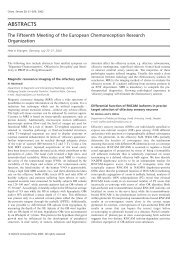XVI International Symposium on Olfaction and Taste - ecro
XVI International Symposium on Olfaction and Taste - ecro
XVI International Symposium on Olfaction and Taste - ecro
You also want an ePaper? Increase the reach of your titles
YUMPU automatically turns print PDFs into web optimized ePapers that Google loves.
<str<strong>on</strong>g>XVI</str<strong>on</strong>g> <str<strong>on</strong>g>Internati<strong>on</strong>al</str<strong>on</strong>g> <str<strong>on</strong>g>Symposium</str<strong>on</strong>g> <strong>on</strong> Olfacti<strong>on</strong> <strong>and</strong> <strong>Taste</strong><br />
Poster sessi<strong>on</strong> I Poster #241<br />
L<strong>on</strong>g-term odor <strong>and</strong> face recogniti<strong>on</strong> as a functi<strong>on</strong> of familiarity<br />
Stina Cornell Kärnekull 1 , Fredrik U. Jönss<strong>on</strong> 1 , Johan Will<strong>and</strong>er 2 , Sikström Sverker 3 <strong>and</strong> Maria Larss<strong>on</strong> 1<br />
1Department of Psychology, Stockholm University, Sweden<br />
2Århus University, Denmark<br />
3Cognitive Science (LUCS), Lund University, Sweden<br />
stina.cornell.karnekull@psychology.su.se<br />
This study investigated episodic recogniti<strong>on</strong> memory for odors <strong>and</strong> faces in the l<strong>on</strong>g-term as a functi<strong>on</strong> of familiarity.<br />
Eighty-three subjects (43 women, 40 men) encoded familiar <strong>and</strong> unfamiliar odors <strong>and</strong> faces <strong>and</strong> memory was assessed at<br />
four occasi<strong>on</strong>s; immediate, 4, 16 <strong>and</strong> 64 days after encoding. The results showed significant forgetting of odors <strong>and</strong> faces<br />
across time, higher overall recogniti<strong>on</strong> memory for faces than for odors, better retenti<strong>on</strong> for familiar than unfamiliar<br />
informati<strong>on</strong>, <strong>and</strong> no influence of gender <strong>on</strong> memory performance. In additi<strong>on</strong>, hit rate performance was positively<br />
associated with naming ability at encoding, although the relati<strong>on</strong>ship was much less pr<strong>on</strong>ounced for faces than for odors.<br />
Interestingly, the decline in odor memory was primarily driven by an increment in false alarm rates over time. This<br />
observati<strong>on</strong> indicates that episodic retenti<strong>on</strong> of olfactory informati<strong>on</strong> is susceptible to the passage of time.<br />
This work is supported by the Swedish Research council to ML.<br />
Poster sessi<strong>on</strong> I Poster #145<br />
C<strong>on</strong>figural percepti<strong>on</strong> of a six-odorants mixture in newborn rabbits <strong>and</strong> human adults<br />
Gérard Coureaud 1 , Charlotte Sinding 1 , Béno Noelle 1 , Adeline Chambault 1 , Thibaut Dosne 1 , Claire Chabanet 1 <strong>and</strong><br />
Thierry Thomas-Danguin 1<br />
1 CSGA, CNRS/INRA/UB, Dij<strong>on</strong>, France<br />
gerard.coureaud@u-bourgogne.fr<br />
Throughout their development, mammals are exposed to complex envir<strong>on</strong>ments. Odours from the surroundings arise<br />
from mixtures of volatiles, <strong>and</strong> even when organisms resp<strong>on</strong>d to key-odour cues, they resp<strong>on</strong>d to cues perceived am<strong>on</strong>g<br />
other. Several perceptual interacti<strong>on</strong>s may occur over mixture coding <strong>and</strong> processing (e.g. synergy/masking). C<strong>on</strong>figural<br />
percepti<strong>on</strong> is another form of interacti<strong>on</strong>. Unlike analytical percepti<strong>on</strong>, based <strong>on</strong> the percepti<strong>on</strong> of the comp<strong>on</strong>ents'<br />
odours, c<strong>on</strong>figural processing leads to the percepti<strong>on</strong> of a new odour, distinct from the odours of the comp<strong>on</strong>ents (in<br />
humans, the effect is called blending effect). Here, we evaluated the percepti<strong>on</strong> of a senary mixture both in human adults<br />
<strong>and</strong> newborn rabbits using in <strong>on</strong>e h<strong>and</strong> (human) a sorting task to get odour resemblance results <strong>and</strong> a 3D-odour-space<br />
representati<strong>on</strong> to illustrate them, <strong>and</strong> in another h<strong>and</strong> (rabbit) single-trial c<strong>on</strong>diti<strong>on</strong>ing to c<strong>on</strong>fer a value to the stimuli <strong>and</strong><br />
behavioural testing (sucking resp<strong>on</strong>se) to quantify their percepti<strong>on</strong>. We used a mixture from which emerges (in humans), at<br />
a specific ratio of odorants, a red cordial odour. First, we showed that the mixture is perceived as being different from its<br />
comp<strong>on</strong>ents in both species: human subjects sorted out separately the mixture <strong>and</strong> its single comp<strong>on</strong>ents; rabbit<br />
ne<strong>on</strong>ates did not resp<strong>on</strong>d to the mixture after learning <strong>on</strong>e comp<strong>on</strong>ent. Sec<strong>on</strong>d, this difference in percepti<strong>on</strong> appeared for<br />
the red cordial mixture, but not for another mixture of six comp<strong>on</strong>ents: human subjects gathered this other mixture <strong>and</strong><br />
some of its comp<strong>on</strong>ents, rabbit pups resp<strong>on</strong>ded to the mixture. Third, the red cordial mixture was no l<strong>on</strong>ger perceived as a<br />
c<strong>on</strong>figurati<strong>on</strong> after modificati<strong>on</strong> of certain or all the comp<strong>on</strong>ents proporti<strong>on</strong>. Thus, percepti<strong>on</strong> of c<strong>on</strong>figurati<strong>on</strong>s in<br />
relatively complex mixtures appears not systematic but dependent <strong>on</strong> chemical compositi<strong>on</strong> <strong>and</strong> comp<strong>on</strong>ents proporti<strong>on</strong>.<br />
The modulati<strong>on</strong> of the percepti<strong>on</strong> presents overlap between species <strong>and</strong> between <strong>on</strong>togenetic stages.<br />
49



